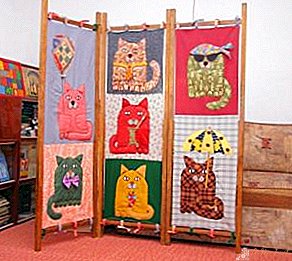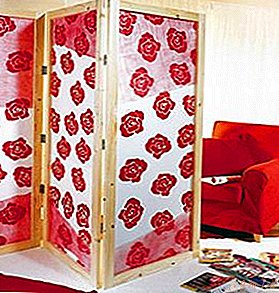 Screens have long been used for zoning rooms, without taking up a lot of space, which is especially true for small apartments. The simplicity of construction and low weight make it possible to store it in the pantry, if necessary, and the use of patterned materials in the decoration of glass will decorate the room and give it an unusual look. In addition, there is no need to spend money on the purchase of products, often expensive, since everyone can do the screen for a room with their own hands. What does that require? Fantasy, some simple materials and time.
Screens have long been used for zoning rooms, without taking up a lot of space, which is especially true for small apartments. The simplicity of construction and low weight make it possible to store it in the pantry, if necessary, and the use of patterned materials in the decoration of glass will decorate the room and give it an unusual look. In addition, there is no need to spend money on the purchase of products, often expensive, since everyone can do the screen for a room with their own hands. What does that require? Fantasy, some simple materials and time.
Do-it-yourself screen for a room - how to make it?
The classic version is a rack or board partition design with a fabric stretched in the middle, but modern models are easily made from almost any material. Depending on the features of the interior and your needs, the screen can be:
 Casement. Represents the frames connected by hinges, the quantity of which is selected individually. Most often, leaflets 3 or 4, while they often perform an exclusively decorative function.
Casement. Represents the frames connected by hinges, the quantity of which is selected individually. Most often, leaflets 3 or 4, while they often perform an exclusively decorative function.- Single screen. It has one leaf, so it does not fold. It occupies a minimum of space and is convenient when zoning the space, representing an impromptu flat wall.
- Agile. The design consists of vertical flexible guides between which the fabric is stretched. A feature of such screens is that they are easily twisted and cleaned, if necessary.
- Cloth. Static models that are attached to the ceiling and are used to separate the bedroom, workplace, etc. Most often, synthetic fabrics and fabrics are the material.
These varieties are far from all, because the popularity of screens is growing steadily, which entails the emergence of new creative models. Their independent manufacture is attractive, first of all, due to its low cost and interesting appearance, the ability to decorate the room and make it more comfortable.
Step-by-step instruction
The process of making a screen with your own hands is fascinating and interesting, does not require experience and expensive materials. She will ideally fit into any interior, will provide an opportunity to retire in order to be alone with her thoughts or read an interesting book.
For a classic partition, consisting of 3 sections, you will need:
 12 bars for the frame with a section of 40x40 mm - 6 pcs. about 2 m long and 6 pieces. a little shorter;
12 bars for the frame with a section of 40x40 mm - 6 pcs. about 2 m long and 6 pieces. a little shorter;- dense fabric, the amount of which is calculated based on the size of the sections;
- decoration elements - photographs, pictures, clippings from magazines, figurines, etc .;
- strong tea leaves for the visual aging of paper elements;
- pencil, tape measure, scissors, square;
- varnish, glue, brushes;
- screwdriver, screws and nails;
- electric jigsaw;
- joiner's stapler;
- 4 compact door canopies;
- decorative braid.
The beginning of work is preceded by drawing up a drawing indicating the dimensions of all the elements and their mounting locations. When assembling, you must constantly consult them in order to avoid errors. The whole process consists of several stages:
- The manufacture of the frame. Wooden blocks are cut to the required dimensions, after which they are assembled into frames and fixed with screws. Their correct fastening and evenness of angles is checked by a square. Further, the sash is opened with two layers of varnish and left to dry.
- Connection sections. To do this, loops are attached to them with screws, while the locations are carefully measured with a tape measure.
- Cut the fabric. In accordance with the previously adopted dimensions, 3 tissue fragments are cut out, which must be further decorated. To do this, the tea leaves is filtered through a fine sieve and applied to paper, which is subsequently ironed. After drying, the sheets are glued to the fabric. Then the fabric is fixed with a stapler in each section with a distance between the brackets of 5 cm.
In conclusion, the attachment points of the fabric are hidden by a braid that adheres around the perimeter of the frames. At the same time, you need to make sure that it is light evenly and accurately.

Alternative - cardboard construction
The most simple and at the same time attractive solution. Such a screen is environmentally friendly and light in weight, while cardboard pipes are used for its manufacture, on which fabric and polyethylene are wound. They are considered waste, and you can easily find them in many stores. To implement this, you will need 18-20 pipes, a piece of strong rope, scissors, a pencil, a tape measure, a drill and drills, paint. Stages of assembly of the structure:
- Pipes are cut to the desired length, while it can be made different. Then they are laid on the floor and aligned on one edge, which will be the bottom of the screen.
- Pencil marks 3 points on each pipe - at a distance of 20 cm from the bottom and 2 more at a distance of 50 cm and 1 m from it, in which holes are then drilled.
- All elements are fastened together by threads and are fixed by nodes at the edges.
If desired, the structure can be painted, including each pipe separately - such a screen will be bright and perfect for a children's room.


 Casement. Represents the frames connected by hinges, the quantity of which is selected individually. Most often, leaflets 3 or 4, while they often perform an exclusively decorative function.
Casement. Represents the frames connected by hinges, the quantity of which is selected individually. Most often, leaflets 3 or 4, while they often perform an exclusively decorative function. 12 bars for the frame with a section of 40x40 mm - 6 pcs. about 2 m long and 6 pieces. a little shorter;
12 bars for the frame with a section of 40x40 mm - 6 pcs. about 2 m long and 6 pieces. a little shorter;
Leave Your Comment